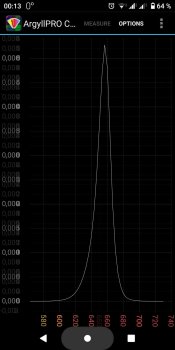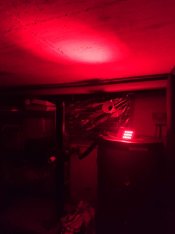In 2017 I soldered a safelight from 25 LEDs, which has been working very well for me. It is a naked prototyping board without case. I have it standing on the hot water tank in the boiler room, which houses my dark room.
The LED are standard 5mm through hole with clear, colourless housing. The semispherical top of the LED does some focussing at I'm getting a large, red spot on the white concrete ceiling which illuminates the room. On top of the tank there is no direct line of sight from the individual LED to the surface of my table, including the base board of the enlarger. Once I lift the paper from the base board to my Nova processor such line of sight will be establised and the paper will also get closer to the red ceiling spot.
So far I haven't noticed any bad effect, including on Foma papers. I did a test once using a step wedge to check if the papers contrast is affected. I can't remember which of my papers I checked, neither the time of exposure to the red light. At full blast I thought that I saw a tiny effect in the deep blacks (i.e. the most transparent steps of the Stouffer wedge) and thus disabled two of the five rows on my 'safe light'. The control was a piece of paper that I handled identically, but in total darkness. I should do a proper test at some point. Especially now that I have a densitometer.
I use Adox MCC/MCP and Fomabrom as well as Fomatone. I was gifted some old Ilford MGIV paper, mostly RC, from 1992 or older. I haven't had any problems with that either.
The array of LEDs is organised into five rows. In each row there are five LED in a serial configuration. If one were to die the entire row would fail. For each row I added a jumper, which can enable/disable the row. As I said, I have only three of the five rows running. It is still plenty bright enough. All 25 LED enabled is obscenely bright.
I'm using a cheap 12V power supply (wall wart type) and soldered an inline switch into the cable. There is one resistor for each row, which I calculated to yield about 20mA of current, which is the nominal value for those LEDs. I can't remember the value but it is easy to calculate: Each LED has a forward voltage drop of nominally 1.8V. 12V-(5x1.8V)=3V. So 3V will have to drop at the resistor and using Mr. Ohms Law I'm getting, wait..., 150 Ohm. The LED have a max rating of 30mA, so 120 Ohm giving 25mA are still good and I may even have used that. Whatever I had around then.
The LED are Kingbright L-53SR superbright LED with peak intensity at 660nm according to the data sheet. Most red LED have a lower wavelength. 660nm is sometimes called deep red.
I have an X-Rite Colormunki Photo to profile my computer screens for more accurate colours. This device is not a colorimeter like most others but a spectrophotometer. It can record a full spectrum. Recently I bought an App for my Android phone and tablet, which uses the Colormunki to give me a Colourmeter.
I used that to check the spectrum of one of those LED. I have two on a non solder breadboard as a make shift savelight for use at home in my bathroom, which is my negative darkroom. Very rarely I develop some direct positive paper at home and I use this then for convenience. I did lower the current for this experiment to prevent saturation of the sensor.
The spectrum I collected shows peak intensity just below the advertised 660nm. It's about 657nm according to this sensor.
There is a little bug in the apps plotter and most of the time the units on the y-Axis are scrambled. I'll have to report that to the author. But using the grid I can see that the peak is about 10.5 major grid units high. So lets say 10 for easy reading from the plot. When I go left and down to 10% intensity it is at 630nm. At 620nm we're at 4% intensity. At 600nm it is barely registering, and at 585nm and below the device can't detect any intensity.
Foma says that the safe light for my two papers should emit above 610 and 625nm. I believe the order was Fomabrom and Fomatone. I didn't look up Fomaspeed. I assume it'll be like Fomabrom FB paper. Ilford and Adox can take safe lights with shorter wavelength, as you know.
In conclusion: This safe light cost me very little money and not much time to solder. Which I did at work with our nice Weller rework station. Thanks boss! After having previously used a simple 230V red darkroom bulb from Dr. Fischer in desklamp this was a major upgrade. I have enough light in the entire room to navigate and a high level at the table. The spectrum of the emitted light looks pretty perfect and in practice I haven't had any noticable problems. What I may want to do at some point is to test in a more scientific manner if there are any measurable effects on paper contrast.













